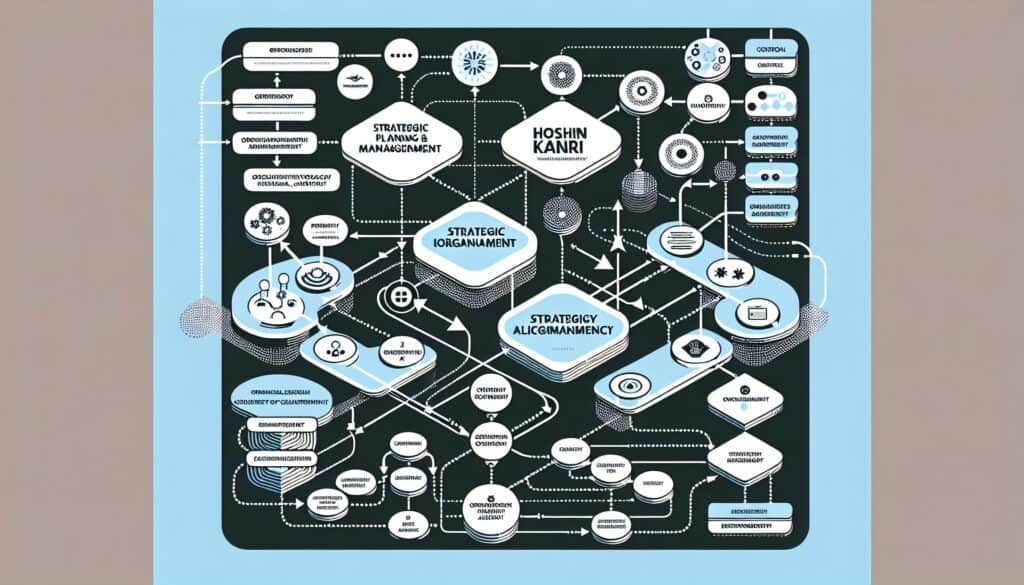A strategic planning and management methodology (also known as Policy Deployment) that aims to align an organization’s overall strategic objectives with specific actions and targets at all levels of the company.
- Metodologie: Clienti e marketing, Economia, Progettazione del prodotto
Hoshin Kanri

Hoshin Kanri
- Gestione del cambiamento, Miglioramento continuo, Collaborazione interfunzionale, Produzione snella, Produzione snella, Pianificare, fare, controllare, agire (PDCA), Miglioramento dei processi, Gestione della qualità
Obiettivo:
Come si usa:
- Top management sets long-term strategic goals (Hoshin). These are then cascaded down through the organization, with each level developing its own objectives and plans (often using a "catchball" process of discussion and alignment) to support the higher-level goals. Progress is regularly reviewed using PDCA cycles.
Professionisti
- Ensures organizational alignment from top to bottom; Focuses efforts on critical strategic initiatives; Promotes cross-functional collaboration and communication; Integrates strategic planning with daily management and continuous improvement.
Contro
- Can be complex and time-consuming to implement effectively, especially in large organizations; Requires strong leadership commitment and a culture of discipline; The "catchball" process needs careful management to ensure genuine alignment and buy-in.
Categorie:
- Economia, Lean Sigma, Produzione, Gestione del progetto, Qualità
Ideale per:
- Aligning the entire organization around key strategic objectives and ensuring that daily activities contribute to achieving those long-term goals.
Hoshin Kanri is commonly used in various industries, including manufacturing, healthcare, information technology, and service sectors, where alignment between strategy and execution is paramount for success. This methodology is particularly effective during the planning phase of a project, allowing organizations to clearly define their strategic vision and translate it into actionable steps that are understood at all levels of the organization. Top management usually initiates the Hoshin Kanri process, but it requires active participation from all employees to develop a sense of ownership and accountability for the objectives set. The “catchball” process encourages idea exchange between different levels of management, enhancing collaboration and ensuring that the objectives reflect realistic capabilities and resources available at various tiers. Regular PDCA (Plan-Do-Check-Act) cycles help in monitoring progress, allowing teams to adjust their objectives and strategies as needed. This iterative approach to management enables organizations to remain agile and responsive to changes in the market or internal challenges while keeping every team aligned with overarching goals. Additionally, Hoshin Kanri promotes a culture of continuous improvement, as the constant review of processes encourages teams to identify inefficiencies and seek innovative solutions to enhance performance across functions. The effective communication fostered through this methodology helps in breaking down silos, ensuring that insights and lessons learned are shared widely across departments, further enhancing the organization’s capacity for innovation and adaptive gestione del cambiamento.
Fasi chiave di questa metodologia
- Define long-term strategic goals (Hoshin) aligned with the organization's vision.
- Translate Hoshin goals into specific objectives for each organizational level.
- Engage in "catchball" discussions to refine objectives and ensure alignment.
- Develop action plans and initiatives that support the objectives at each level.
- Implement PDCA (Plan-Do-Check-Act) cycles for continuous improvement and progress tracking.
- Regularly review progress toward strategic goals and adjust plans as necessary.
Suggerimenti per i professionisti
- Incorporate real-time data dashboards to provide immediate visibility into progress against Hoshin objectives, facilitating agile decision-making at all levels.
- Utilize root cause analysis during PDCA cycles to rigorously investigate issues as they arise and adjust strategies proactively, rather than reactively.
- Establish cross-departmental Hoshin teams to ensure that initiatives are not siloed, promoting diverse perspectives during the catchball process and enhancing collective ownership of goals.
Leggere e confrontare diverse metodologie, raccomandiamo il
> Ampio archivio di metodologie <
insieme ad altre 400 metodologie.
I vostri commenti su questa metodologia o ulteriori informazioni sono benvenuti su sezione commenti qui sotto ↓ , così come tutte le idee o i link relativi all'ingegneria.
Contesto storico
1950
1980
1980
1986
1994
1995
2000
1960
1980
1983
1990
1995
2000
2010
(se la data non è nota o non è rilevante, ad esempio "meccanica dei fluidi", viene fornita una stima approssimativa della sua notevole comparsa)














Post correlati
Questionari sul disagio muscoloscheletrico
Test multivariati (MVT)
Analisi di regressione multipla
Sistemi di cattura del movimento
Metodo MoSCoW
Test mediano dell'umore